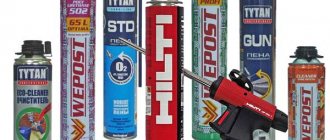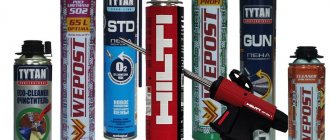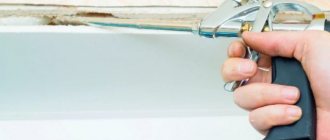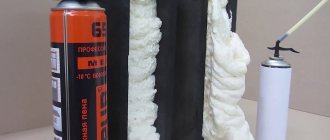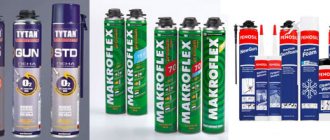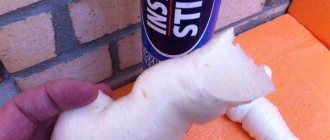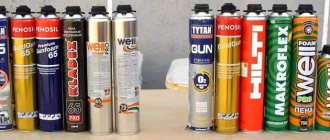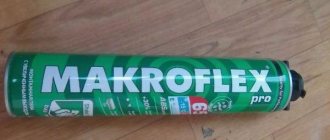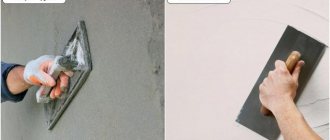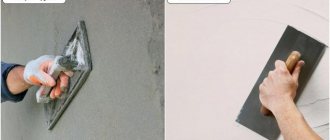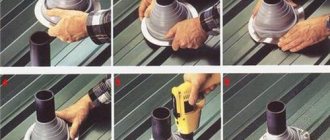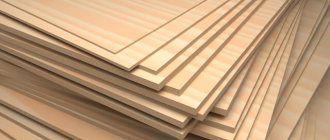Polyurethane foam TYTAN LEXY 20 300 ml. Photo by Maxidom
Polyurethane foam is an indispensable material when solving a wide range of tasks in construction, when carrying out finishing and repair work. Foam is the ideal solution for filling space as efficiently . The demand for polyurethane compounds is ensured by a large variety of products offered. Foam with a low expansion coefficient occupies a special place. This variety has its own individual characteristics, which determine the scope of application.
Types depending on the expansion rate
Primary or main expansion is the increase in volume of foam after it exits the balloon nozzle. This indicator is a positive characteristic. The foam expands, which ensures its compaction at the point of application and guarantees economical consumption. The mechanism of this process is as follows. The prepolymer and gases are located in a cylinder under a pressure of about six atmospheres. Before use, the container is thoroughly shaken, the gases are mixed and partially dissolved in the prepolymer. When leaving the cylinder, a sharp drop in pressure , gas bubbles expand and foam forms. The amount of primary expansion depends on several factors: temperature and humidity, method of application, qualifications of the performer, brand/manufacturer.
Secondary expansion is an increase in volume after the end of the primary and before complete polymerization. Measured as a percentage. Occurs as a result of the interaction of prepolymer and moisture. As a result of the reaction, carbon dioxide is released and the foam hardens. The secondary expansion rate varies depending on the formulation used. Therefore, the parameter differs for different manufacturers and types of foam; it can range from 15 to 60% for professional compositions and from 200 to 300% for household use. Secondary expansion is an important indicator that affects the quality of work performed . Therefore, it is first necessary to conduct an experiment, accurately determine the indicator of secondary expansion and take this parameter into account when working. Since an increase in volume can lead to deformation of structures.
Currently, manufacturers produce the following types of polyurethane foams:
- with a minimum expansion coefficient (or non-expanding);
- with average expansion rates;
- strongly expanding.
Features of the material
To judge the drying speed of the sealant, you need to understand its features :
- After leaving the container, the volume immediately increases initially. The sealant fills the entire space down to the smallest cracks.
- When the polyurethane is already exposed to air, secondary expansion occurs. This feature can have a big disadvantage if the conditions of use are not followed. Polyurethane foam reduces volume in case of extreme heat, dirty base or premature mechanical impact.
- The surface layer of household foam hardens in 20 minutes. You can cut off the excess after 4 hours. A two-component sealant hardens faster. The chemical process is completed within a day.
- A feature of the installation material is increased adhesion. Polyurethane adheres well to glass, wood, concrete, plastic, steel, and stone.
- Cured polyurethane does not react to temperature changes.
- The mounting sealant is afraid of UV rays. When exposed to the sun, it turns orange-brown and breaks down.
Polyurethane foam serves only as a sealing material. The hardened polyurethane on top must be protected with putty, paint, and primer.
What is non-expanding foam?
Non-expanding polyurethane foam is a special type of composition (sealants) , the volume of which, after hardening, increases by no more than one and a half times. It is the best option for performing work using delicate materials. The following types of sealants have a low expansion rate:
- silicone , characterized by a high level of interaction with most surfaces, have good adhesion to smooth materials;
- polyurethane - standard mounting foams, the composition of which is based on liquid polyurethane;
- acrylic ones , which do not contain solvents, have a lower level of resistance to external aggressive factors.
Precautionary measures
The cylinder is filled with gas that comes out along with the polyurethane. Additionally, butane and carbon dioxide are released during polymerization. Work must be carried out in a ventilated area.
Gas is flammable. The presence of open sources of fire is unacceptable. It is prohibited to heat cylinders with burners or throw them into a fire.
Work is performed only in special clothing. Sticky foam is difficult and painful to remove from the body. Be sure to cover objects located near the work. Adhered foam is removed with special solvents or folk remedies are used: vegetable oil, Dimexide, salt solution.
After foaming, do not rush to cut off the cap. If you have extra time, it is better to wait. It is not possible to accurately determine the final polymerization period. Premature removal of excess will ruin the entire job.
Where is it important to use foam that does not expand much: for interior doors and not only
Non-expanding polyurethane foam is used to seal cracks from 10 to 100 mm. Gaps of these sizes can form when solving various problems : installing door frames and window frames, wiring communications and pipelines, sealing joints in various rooms and when carrying out external work, etc.
Polyurethane foam TYTAN Professional Lexy 60 all-season 750 ml. Photo Petrovich
It should be understood that to fill spaces of minimal dimensions it is necessary to use sealants rather than polyurethane foams. This choice is best for spaces with a depth of no more than 10 mm. Polyurethane foam is also suitable for fixing (gluing) delicate materials.
CYLINDER VOLUME AND CYLINDER FILLING VOLUME
The volume of the polyurethane foam canister is indicated in milliliters and is usually placed in a rectangular frame (1000 ml); the volume of filling the liquid product in the canister is also indicated in milliliters and placed nearby.
The weight of a fully filled cylinder is comparable to the weight of a carton of milk. Remember that you are paying money precisely for the useful weight of the cylinder, and one fully filled cylinder will cope with more work than several half-empty ones.
If at the end of the work there is foam left in the cylinder, you can easily reuse it, but be sure to prepare it for storage.
The nuances of using non-expanding foam
There are several recommendations to ensure the effectiveness of using polyurethane foams with a low coefficient of expansion:
- non-expanding foams are best suited for cracks and gaps from 10 to 100 mm;
- joints with a width and depth of no more than 10 mm. it is necessary to seal with more plastic compounds , including sealants that have a zero expansion rate;
Soudal super-elastic all-season pistol foam 750 ml. Photo by Leroy Merlin
- for joints more than 100 mm wide. It is recommended to use a special sealant together with polyurethane foam , which reduces the space for filling, which allows you to significantly save the composition consumption and minimize the likelihood of the foam slipping by its own weight;
- to improve adhesion, the surface to be treated must be moistened with water;
- after initial drying, it is recommended to spray the seam with a spray bottle;
- When performing work, it is recommended to use personal protective equipment, since frozen foam is difficult to remove from skin, clothing and work surfaces;
- polyurethane foam has poor adhesion to some materials : Teflon, polyethylene, polypropylene, as well as to uncleaned and greasy surfaces;
- Before use, the container must be shaken thoroughly for 30 seconds;
- for better mixing of foam, it is necessary to hold the container upside down;
- throughout the entire shelf life, the foam should have a pale yellow color;
- it is necessary to cut off excess foam only after complete hardening;
- To increase the service life, the dried foam must be painted, plastered or puttied.
Representatives
The quality of the material is associated with the reputation of the manufacturer. When choosing polyurethane foam, it is better to look at popular brands. They have been tested by many masters and meet all requirements. At the same time, the price category of different compositions can vary greatly.
The most famous brands of polyurethane foam and their features:
- Soudal - available in winter, summer, fire-resistant versions. High-quality foam with no shrinkage. Has a slight odor. Approximate price – 200-350 rubles.
- Moment Installation - common in various hardware stores, but most products from the manufacturer have a high expansion coefficient. The composition is characterized by a homogeneous and dense structure. However, after a few years the foam loses its elasticity. Price – from 150 rubles.
- Macroflex – adheres well to homogeneous structures. Lately there have been a lot of complaints about Macroflex, which is associated with the appearance of counterfeits. The original product costs about 170 rubles.
- Titan is a well-known brand; the company produces high-quality foam without shrinkage and with low secondary expansion. It is often used for thermal insulation. The product yield is average. The approximate price starts from 200 rubles.
- Penosil is a bright white foam, has a low expansion coefficient, and is used primarily for outdoor work. Cost – from 200 rubles.
There are some points that you should pay attention to before purchasing. The first is the condition of the packaging. If there is damage, this may affect the cylinder's ability to function properly. Improper storage of the product in packaging leads to a deterioration in the final result of its use.
Expiration date is important. After its expiration, it is no longer possible to use polyurethane foam, since the characteristics of the finished material will not meet the required parameters. When purchasing, you need to shake the bottle several times. If you can hear the liquid flowing easily inside, then everything is in order. But it may also happen that pieces of the already hardened composition begin to fall to the bottom, then it is not at all suitable for work. The weight of the cylinder should be slightly greater than stated. If it is equal to that indicated on the package, the output will be a smaller amount of the finished composition.
You also need to look at the type of polyurethane foam. It can be winter (-10-35 degrees), spring (-10+35 degrees) and summer (+5+30 degrees). When working with seasonal mixtures, you need to focus on the permissible temperatures of use. It is better to warm up winter ones to +10 degrees before application, which will significantly improve the characteristics of the material.
You need to focus on the expansion coefficient according to the instructions, but other factors are also important. The increase in volume of the finished mixture can be affected by weather conditions, temperature, and duration of hardening. If you do not follow the rules for working with a particular composition, the result obtained will be far from that declared by the manufacturer.
Rules for using polyurethane foam (2 videos)
Polyurethane foam with a low coefficient of expansion: varieties, manufacturers (16 photos)
Manufacturers of products with minimal expansion, which is the best low expansion
The quality of polyurethane foam directly depends on the manufacturer. Therefore, when choosing, you need to pay special attention to products from well-known brands. In addition, all large and leading market enterprises offer a wide range of formulations, which also include non-expanding options:
- Belgian ]Soudal[/anchor] offers professional Soudafoam Professional 60, gun sealing Low Expansion and super-elastic Flexifoam foam;
- TECHNONICOL from Russia offers the BALANCE line , characterized by moderate primary and low secondary expansion, and CONSTANT , which is characterized by moderate primary and minimal secondary expansion.
- Professional Low Expansion , a professional foam with high performance and the lowest expansion, and the LEXY line of household foams are sold under the Polish brand Tytan ; The professional compositions of the brand have no analogues in terms of minimal expansion indicators;
- Penosil (Estonia) produces all-season foam GoldGun Low Expansion 750 ml with especially low expansion for performing work at a professional level;
- The Russian company KUDO offers PROFF 65 compositions , the secondary expansion of which does not exceed 30%, i.e. it expands the least.
A separate article presents other manufacturers and product options, including those with a low expansion coefficient; details are here.
Are there ways to reduce the drying time of polyurethane foam?
It is recommended to create optimal conditions before work begins. But often it is almost impossible to achieve this. It is permissible to influence the humidity level. With enough liquid, adhesion increases. This is one of the options for speeding up the drying of polyurethane foam.
The foam must be laid so that about 1/3 of the joint cavity is occupied. The rest of the space will fill in on its own as the train expands.
Pistols with long barrels help you reach hard-to-reach places. They do not affect how much polyurethane foam expands.
There are other rules at work:
- It is important to provide adequate space for the release of polyurethane foam. The review should not be closed. Therefore, the tube spout is installed at an angle of 45 degrees.
- If there is a short break in work, the cylinder can be left in the gun. Then the mass will not solidify in the valves and tubes.
- The seam should be made evenly, without excess. The nose of the tube is almost completely immersed in the foamed composition.
If you need to foam the surface of the walls, make a wooden sheathing that looks like square cells. This helps keep the layers on the surface until drying is complete. How long it takes construction foams to dry has already been described earlier.
How to choose
To carry out small-scale work, it is necessary to choose household foam in containers with an applicator tube ; a simple mechanism provides the composition from the container and facilitates the work. The need for a significant amount of foam implies the purchase of professional formulations, produced in cylinders for a pistol . Products for household work are sold in small-volume cylinders. While professional foam provides a significant amount of material.
The expansion coefficient is indicated on foam cylinders; this characteristic is the main one when choosing products, since recommendations for performing work depend on the indicator.
When purchasing, you must pay attention to the integrity of the packaging if the consumer does not use the services of online stores. The container should not have scratches, dents or other mechanical damage.
It is recommended to turn the cylinder over several times. The composition inside should roll easily. If it falls, then most likely the hardening process has already begun. It will not be possible to mix such a composition well.
It is imperative to check the expiration date of products. The “fresh” the foam, the better qualities it has.
Types of Silicone Sealants
1. Acidic.
The most versatile and cheapest (from two and a half dollars for a 310 ml bottle). As a rule, the labeling contains the Latin letter “A” (“Acid” - acid).
Acidic sealants are not recommended for use on metal surfaces, as the acetic acid released during curing can cause corrosion. Preliminary tests must be carried out on marble and cement materials. Alkaline compounds in their composition can react with acid.
2. Neutral.
When cured, they release ketoximil alcohol, which is safe for metal, cement and marble surfaces. The cost of neutral sealants is higher (from four to five dollars per bottle).
The marking contains the Latin letter “N” (“Neutral” - neutral).
3. Alkaline.
Amine based sealants. They are used very rarely to solve special problems (which the above materials cannot cope with). They are almost never found on sale.
Requirements
Polyurethane foam is a material that, like any other, has a number of requirements.
These requirements include:
- good surface bonding;
- elasticity;
- after hardening, the material should not crumble, even when exposed to sub-zero temperatures;
- The shrinkage of the solution, which has already dried, should be moderate.
We draw the attention of users to the fact that the foam is very resistant to direct sunlight. For this reason, after complete hardening, the excess is cut off, and all compacted areas are treated with paint or plaster. And in order not to disturb the density of the material and to do the application sequence correctly, you need to know how much time is needed for complete hardening.
To eliminate gaps between door frames and openings, you will need only a third of the sealing compound. The material will begin to harden on the surface within half an hour after application. You may notice that a film will appear on the surface.
Final drying can be expected 8 hours after the material is applied. The fixing process occurs due to the expansion of the substance, which leaves the container and hardens.
Conventionally, this is divided into several stages:
- primary, which is carried out immediately at the exit from the package;
- secondary, which is not completed until the final transformation of the foam into a solid composition.
If the material is of high quality, then at the second stage the expansion rate can reach 30%; this must be taken into account during the work process. Most often, a third of the material is spent filling the space; this is enough to fill all the cracks during expansion.
But you should also pay attention to the fact that the foam should shrink; you should not be afraid of this action, it will not cause problems. In high-quality materials, shrinkage can reach 5%, and this is not noticeable from the outside. If shrinkage does occur, and this is clearly visible from the outside, it means that the polyurethane was purchased of poor quality.
